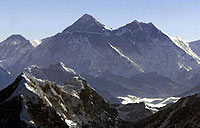




KATHMANDU—Nepal is best known as home to Mount Everest, but the world's tallest peak soars over a country of massive disparities in wealth and a Maoist rebel movement aiming to stir up anti-government sentiment among the country's 27 million people.
Nepal became a constitutional monarchy led by an elected parliament in 1990, 30 years after King Mahendra ended a year and a half of democracy by seizing power and restoring feudal rule in which the king was considered an incarnation of the Hindu deity Vishnu.
King Gyanendra became king in June 2001 after his brother King Birendra and most of the royal family were shot dead in a drug-induced rampage by the former crown prince, who then killed himself.
The countryside is extremely poor, with high rates of malaria and malnutrition and most people earning below the kingdom’s average per capita income of about U.S. $250 a year. Japan, Germany, Britain, and the United States are major aid donors.
Subsistence agriculture supports more than 80 percent of the population, and the mixed economy suffered due to slow growth in the world economy and the insurgency.
Maoist rebels, who say they are inspired by the late Chinese revolutionary leader Mao Zedong, have been trying since 1996 to overthrow the government and establish a socialist state. More than 10,500 people have died since the fighting began.
"There are three main groups in Nepal—the elite and army who are fully for the king; the political class and the people which accepted the monarchy as part of the fabric of society; and the third, led by the Maoists, who despise the monarchy," said S. Chandrasekharan, director of the New Delhi-based South Asia Analysis Group told AFP.
"The country is still feudal with the elite getting most of the benefits…This has led to a sharp split of rural Nepal from Kathmandu, with the Maoists fully in control of 15 to 20 districts out of 75 and partially dominating another 55 districts," Chandrasekharan said.